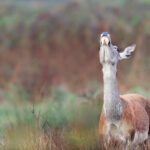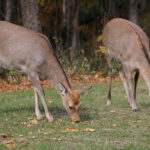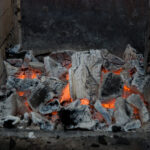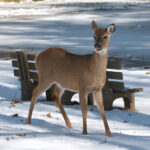We’ve all heard the myth that werewolves jump into action on a full moon – but what about real canines, like coyotes?
Images of coyotes and wolves howling at the moon are iconic, so it’s easy to imagine that those in the dog family are more active on a night when the moon looks large.
Yet research shows that this may just be a myth. So are coyotes actually more active during a full moon?
Let’s get into it!
Table of Contents
- Are Coyotes More Active During A Full Moon?
- A Full Moon Might Actually Decrease Coyote Activity
- In Urban Areas, Coyotes Are More Active At Night
- Coyotes Come Out During The Day More Often In Rural Areas
- Do Coyotes Howl More At A Full Moon?
- What Influences Coyote Activity?
- What About Wolves – Are They More Active On A Full Moon Night?
- Where Does The Full Moon Myth Come From?
- Final Thoughts
- Related Posts
Are Coyotes More Active During A Full Moon?
When comparing nocturnal coyote activity during different phases of the moon, one study found no difference between nights with new moons, quarter moons, and full moons.
Animals that rely on vision are assumed to be more active on full moons since they have more light to see with.
However, coyotes have a great sense of smell that they also use to hunt – they can even catch rodents hiding underneath the snow. So increased vision might not be as useful to the coyote.
A Full Moon Might Actually Decrease Coyote Activity
Coyotes are usually most active in the very early morning and late evening, when it is dark out.
But the size of the moon does not seem to increase their activity. In fact, the brightness of a full moon might make it more dangerous for coyotes to wander and hunt at night because they have predators of their own that they need to hide from.
With the extra light of a full moon, their light fur is more easily spotted at night by mountain lions and wolves, two of their top predators.
Depending on whether these predators are present in the area, coyotes may reduce the time they wander around on a full moon to avoid being seen by them.
In general, though, the moon does not affect their behavior.

Humans are also frequent hunters of coyotes. Coyotes have good night vision, so they don’t need much extra light to hunt at night.
But humans aren’t gifted with the same night vision, which makes a bright moon helpful to those who hunt at night.
So if you’re a night hunter looking for coyotes, the only advantage of a full moon would be the extra light it provides you!
Coyote movement is not connected to the phase of the moon, but it does depend on the time of day and who else is around.
In Urban Areas, Coyotes Are More Active At Night
Coyotes are sometimes spotted during the day, but in more densely populated areas they tend to be more active at night to avoid humans.
They often prowl throughout neighborhoods searching for things to eat – including leftover food in the trash, fruit fallen from trees, rodents, and occasionally outdoor cats and other small pets.
Regardless, the phase of the moon doesn’t affect their activity in urban areas.
Coyotes Come Out During The Day More Often In Rural Areas
With fewer humans around, coyotes often hunt during the day.
Despite their tendency to be active at night in urban areas, they are not naturally nocturnal animals – their vision is better suited for daylight or dawn and dusk.
Their sleep schedules can vary; if conditions allow for it, they will sleep at night and travel during the day.
But if more prey and fewer threats – like humans – are around during the night, they will likely choose to hunt then.
Do Coyotes Howl More At A Full Moon?
One study found that coyote group howling decreased with more moonlight. Howling is an indicator of communication and activity, so this suggests that coyotes reduce their activity on full moon nights.
Howling, however, is not directly linked with hunting: coyotes do not want to attract other animals to the prey that they have just caught.
Howling more likely implies territory defense and foraging behavior (for example, finding fruit or leftovers of a different kill).
Meanwhile, it’s possible that the decrease in vocalizations (howling, barks, and yips) on nights well-lit by the moon could be because they’re not as necessary.
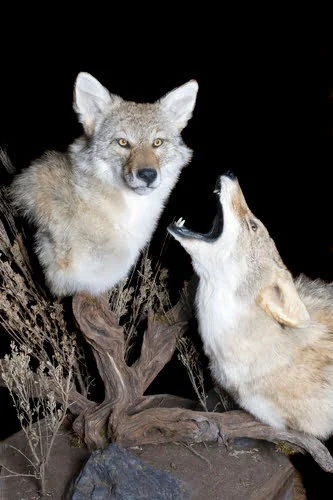
On nights with less moonlight, more communication may be needed between coyotes that can’t see each other as well in the dark.
There was also no difference in the amount of howling lone coyotes did on full moon versus new moon nights.
So group behavior may be slightly affected by moonlight, but solo behavior is probably not.
What Influences Coyote Activity?
Lunar cycles may not affect coyotes significantly, but seasons play a large role in their behavior and movement.
During their breeding season from January to March, many coyotes are on the move to find a mate. In the spring and summer, they are likely traveling less as they stay close to their dens to raise pups; their behavior, however, becomes more aggressive.
Weather can also affect coyote activity. They usually don’t move as much on days that are very hot or windy.
What About Wolves – Are They More Active On A Full Moon Night?
Like coyotes, wolves are active at night, so are often associated with the moon – but a full moon doesn’t increase their activity either.
In fact, their prey tends to do a better job hiding during full moons.
In response, wolves typically travel less during those nights, probably because the chance of finding prey is reduced.
Where Does The Full Moon Myth Come From?
Stories connecting coyotes and wolves to the moon are common across cultures. The idea has been passed down through ancient folklore and has originated separately in different communities.
There may not be any data supporting the link between canines and full moons, but it is a romantic image that will likely be around for a while.
Final Thoughts
In general, coyotes are not more active during a full moon. That being said, there are several factors that can influence whether extra moonlight is useful or harmful to the animal.
If hunters or other coyote predators are active at night, the light of a full moon is a disadvantage to coyotes with their light fur.
However, if circumstances – such as the presence of humans during daylight and twilight hours – force coyotes to travel or hunt in the middle of the night, they may be more active with a full moon since their vision is not adapted to complete darkness.
The full moon-canine relationship might be more myth than fact, but it’s easy to see how the theory came into existence!
